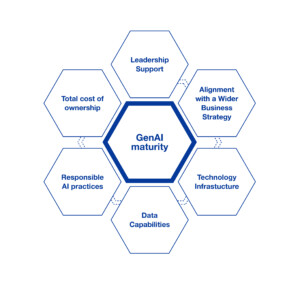As organizations look to implement GenAI into their day-to-day operations, navigating this development journey proves daunting. However, with our Maturity Framework, organizations can better understand the GenAI landscape, and how mature they are within this field.
The need for a Maturity Framework
Whenever organizations undergo a development journey within a particular field, it is wise to better understand the field’s wider landscape. With this information, they can find the optimal route to pursue. However, finding these many routes and weighing up these many options is time-consuming.
In the case of GenAI, this becomes especially difficult. Firstly, the field is one of the most dynamic fields in modern technology. What was once considered cutting-edge technology can become redundant within six months. Secondly, GenAI carries significant risks. Given the ethical and legal concerns with the technology, particular diligence needs to be taken when exploring options for developing the technology within organizations.
Therefore, a framework that outlines key considerations, and demonstrates an organization’s maturity within this field, is necessary to understand the GenAI field and how to navigate through it.
Our GenAI Maturity Framework delivers on this necessity.
What is the Maturity Framework
The GenAI Maturity Framework outlines six key domains to consider and five stages of development, coming together as a matrix.
The six domains, along with their definitions, include:
- Leadership support: the extent to which leaders are pushing for GenAI to be an integral part of their organization.
- Alignment with wider business strategy – the extent to which an organization has related GenAI back to business value.
- Technology infrastructure – the extent to which an organization’s physical and digital infrastructure can support the use of GenAI.
- Data capabilities – the extent to which an organization’s current data capabilities can support the use of GenAI.
- Responsible AI practices – the extent to which an organization mitigates the ethical and legal risks related to GenAI.
- Total cost of ownership – the extent to which an organization has clear visibility on costs and high ROI.
The five stages of development, along with a further explanation, include:
- Initial ⇒ organizations have a minimal understanding of the domain in question (if any), and have implemented a minimal number of relevant practices (if any).
- Developing ⇒ organizations have some understanding of the domain in question and have implemented some relevant practices.
- Defined ⇒ organizations have a comprehensive understanding of the domain in question, and have comprehensive practices in place.
- Managed ⇒ organizations actively seek to understand the domain in question, and actively seek to improve the practices they implement.
- Optimized ⇒ organizations’ understanding of the domain in question is industry-leading, and the practices they have implemented are also industry-leading.
Explanation of its features
Leadership support
Leaders set the tone in organizations. They steer the ship by allocating time and resources to particular tasks and ventures. Given how convoluted, ever-changing, and daunting the GenAI field can be, time and effort must be allocated to explore options, sandbox technologies, and invest resources. Without this, the necessary due diligence cannot take place to ensure optimal outcomes.
Therefore, leadership support is key to developing, deploying, and benefiting from GenAI technology.
Alignment with wider business strategy
As everyone knows, there has been a lot of discussion around the GenAI field since the release of Chat GPT 4. Initially, businesses asked themselves ‘what can GenAI do?’. Two years later, with this now well established, the question has now become, ‘what can GenAI do for me?’
This is encouraging to see from businesses. As useful as technology can be, having it for its own sake is not. If a business cannot link its technology back to business value, it is unlikely its’ potential is being maximized. GenAI is no different. How can an organization expect to thrive when there is no clear idea of how the purchase of technological products or services will return financial gain, if any?
With this in mind, it is clear that alignment to a wider business strategy is key to maximizing the benefits of GenAI for organizations.
Technology infrastructure
This is where the domains become more technical.
When we think of digital technology, infrastructure usually falls into either the hardware or software domain. But with GenAI, such a simplification is insufficient. Just to even scrape the surface, key infrastructure considerations include servers, HPC clusters, storage solutions, memory systems, networking infrastructure, and compliance infrastructure. Given this list is not exhaustive, it is clear there are many moving cogs in the machine of technology capabilities.
Fortunately, though, the majority of companies will have many of these infrastructures in place. In recent years, the need for digitization has forced many organizations to start building these technology infrastructures. Nonetheless, it is unlikely these same companies will have everything necessary to support GenAI.
Given that GenAI can only be as strong as the infrastructure it is built on, technology capabilities are integral to its success.
Data capabilities
While data capabilities are intertwined with technology infrastructure, they still require their own domain.
At its core, GenAI is run on data. Behind all the RAGs, the vectors, and the embeddings, there is simply organised data. This data is so vast and so well organized, that GenAI can recognize tone, slang, and other human forms of self-expression.
Given this, it is important to recognize that GenAI will be built on whatever pre-existing data capabilities an organization has. In turn, not only do current data issues need to be cleaned up, but they also need to be strengthened to handle GenAI’s data volumes. If scalability, latency, or data quality are already challenges, GenAI will inflame these challenges.
Due to its significance in GenAI’s functioning, and how previous structures will affect current outputs, data capabilities are worth significant attention when implementing GenAI.
Responsible AI practices
As many know, GenAI carries significant risks. In fact, governmental institutions worked extensively into writing comprehensive legislation that ensures its safe use, with the EU AI Act being one of the biggest results of these efforts.
With this wave of legislation, there are both more significant number of responsibilities organizations are expected to fulfill. Examples of these responsibilities include managing the risks of biases, deepfakes, data privacy, and cyber security. Again, this list is not exhaustive.
In addition, legislators are placing greater emphasis on observability. What this means is that organizations are expected to explain how they are managing these risks rather than just managing them. Simply not getting caught for breaches is insufficient. Considering how drastic failure to manage these issues can be, organizations are expected to explain how they are avoiding GenAI legislation breaches.
Considering how costly failure to comply can be for organizations, be that financially, operationally, and even ethically, responsible AI practices require significant attention when implementing GenAI capabilities.
Total cost of ownership
During any development journey, cost is always a concern. Naturally, businesses cannot sustainably function unless they either break even or make a profit. Therefore, understanding where your investment is going and whether this investment could be more strategic is integral to successful GenAI implementation.
Additionally, given that AI is going to be a common feature of the future, building an investment strategy that can generate significant ROI will help provide wriggle room for other investments. In contrast, if companies pursue a technology that drains budgets, there is less money available to invest in other important technologies, talent, or operational practices.
Given both the general role that cost management plays in organizations and how financially draining AI could be to them if a sufficient ROI is not found, the total cost of ownership is worth immense attention by business leaders.
The final framework matrix
Initial |
Developing |
Defined |
Managed |
Optimized |
|
| Leadership support | Minimal support | Some support | Comprehensive support | Actively supporting | Industry-leading support |
| Alignment to wider business strategy | Minimal alignment | Some alignment | Comprehensive alignment | Actively improving alignment | Industry-leading alignment |
| Technology infrastructure | Minimal infrastructure | Some infrastructure | Comprehensive infrastructure | Actively building/ improving infrastructure | Industry-leading infrastructure |
| Data capabilities | Minimal capabilities | Some capabilities | Comprehensive capabilities | Actively building/ improving capabilities | Industry-leading capabilities |
| Responsible AI practices | Minimal responsibility taken | Some responsibility taken | Comprehensive responsibility taken | Actively taking responsibility | Industry-leading responsibilities taken |
| Total cost of ownership | Minimal clarity on cost and minimal ROI | Some clarity on cost and some ROI | Comprehensive clarity on cost and comprehensive ROI | Actively clarifying and actively improving ROI | Industry-leading clarity on cost and industry-leading ROI |
Conclusion
As GenAI continues to develop at a head-spinning pace, having a map that outlines where GenAI developments can be made, and in what way they can be made, will support business leaders in guiding their GenAI development.
Given the current pressures to use it, and its use cases are increasing, now is the time to outline key domains of focus. As highlighted, leadership support, alignment to wider business strategy, technology infrastructure, data capabilities, responsible AI practice, and total cost of ownership are these key domains that are integral to successful Gen AI implementation.
To find out how a GenAI Maturity Framework would benefit your organization, please sign up for a workshop.



